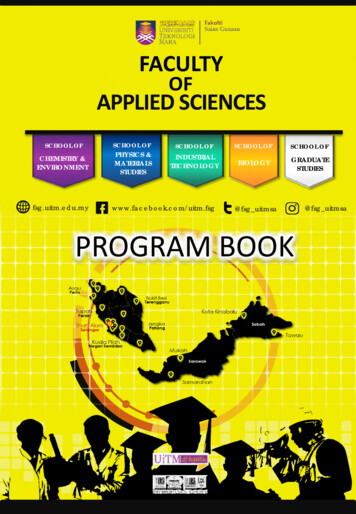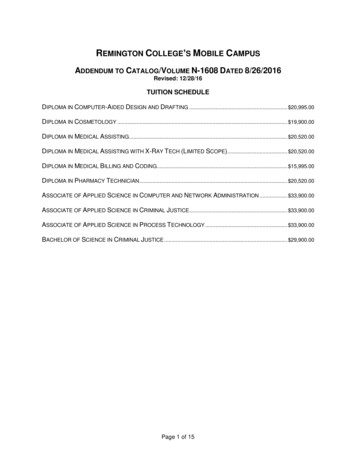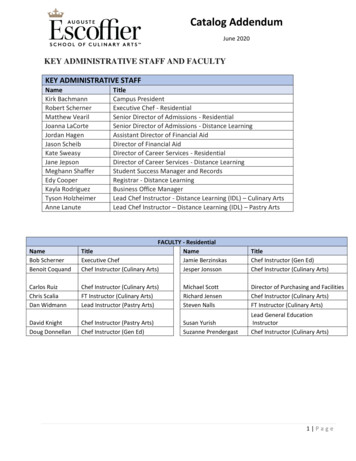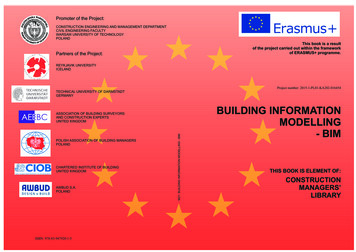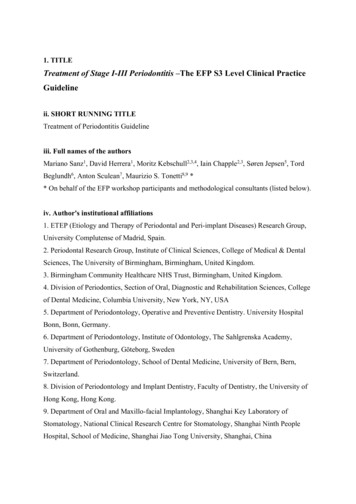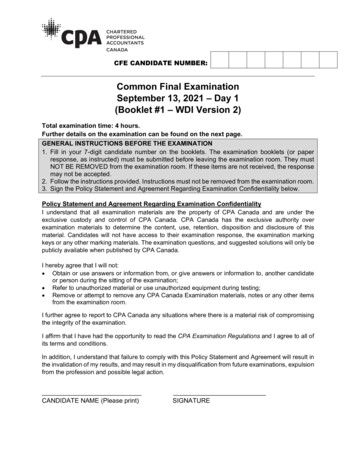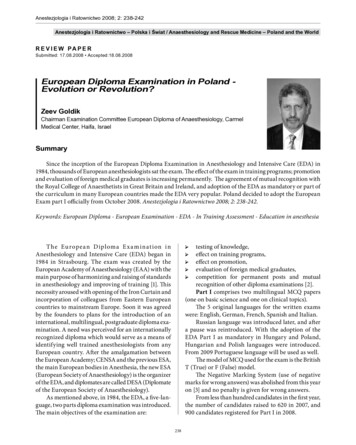
Transcription
Anestezjologia i Ratownictwo 2008; 2: 238-242Anestezjologia i Ratownictwo – Polska i Świat / Anaesthesiology and Rescue Medicine – Poland and the WorldR E V I E W PA P E RSubmitted: 17.08.2008 Accepted:18.08.2008European Diploma Examination in Poland Evolution or Revolution?Zeev GoldikChairman Examination Committee European Diploma of Anaesthesiology, CarmelMedical Center, Haifa, IsraelSummarySince the inception of the European Diploma Examination in Anesthesiology and Intensive Care (EDA) in1984, thousands of European anesthesiologists sat the exam. The effect of the exam in training programs; promotionand evaluation of foreign medical graduates is increasing permanently. The agreement of mutual recognition withthe Royal College of Anaesthetists in Great Britain and Ireland, and adoption of the EDA as mandatory or part ofthe curriculum in many European countries made the EDA very popular. Poland decided to adopt the EuropeanExam part I officially from October 2008. Anestezjologia i Ratownictwo 2008; 2: 238-242.Keywords: European Diploma - European Examination - EDA - In Training Assessment - Education in anesthesiaT he Eu ropea n Diploma E x a m i nat ion i nAnesthesiology and Intensive Care (EDA) began in1984 in Strasbourg. The exam was created by theEuropean Academy of Anaesthesiology (EAA) with themain purpose of harmonizing and raising of standardsin anesthesiology and improving of training [1]. Thisnecessity aroused with opening of the Iron Curtain andincorporation of colleagues from Eastern Europeancountries to mainstream Europe. Soon it was agreedby the founders to plans for the introduction of aninternational, multilingual, postgraduate diploma examination. A need was perceived for an internationallyrecognized diploma which would serve as a means ofidentifying well trained anesthesiologists from anyEuropean country. After the amalgamation betweenthe European Academy; CENSA and the previous ESA,the main European bodies in Anesthesia, the new ESA(European Society of Anaesthesiology) is the organizerof the EDA, and diplomates are called DESA (Diplomateof the European Society of Anaesthesiology).As mentioned above, in 1984, the EDA, a five-language, two parts diploma examination was introduced.The main objectives of the examination are: testing of knowledge,effect on training programs,effect on promotion,evaluation of foreign medical graduates,competition for permanent posts and mutualrecognition of other diploma examinations [2].Part I comprises two multilingual MCQ papers(one on basic science and one on clinical topics).The 5 original languages for the written examswere: English, German, French, Spanish and Italian.Russian language was introduced later, and aftera pause was reintroduced. With the adoption of theEDA Part I as mandatory in Hungary and Poland,Hungarian and Polish languages were introduced.From 2009 Portuguese language will be used as well.The model of MCQ used for the exam is the BritishT (True) or F (False) model.The Negative Marking System (use of negativemarks for wrong answers) was abolished from this yearon [3] and no penalty is given for wrong answers.From less than hundred candidates in the first year,the number of candidates raised to 620 in 2007, and900 candidates registered for Part I in 2008.238
Anestezjologia i Ratownictwo 2008; 2: 238-242Anestezjologia i Ratownictwo – Polska i Świat / Anaesthesiology and Rescue Medicine – Poland and the WorldPART I (MCQ)YearTotal sitting theexamPass19841021985611986198719881989Fail% Fail40030020010019819 4819 5819 6819 78819819 9919 0919 1919 29319919 4919 5919 6919 79819920 9020 0020 10220020 3020 4020 5060239
Anestezjologia i Ratownictwo 2008; 2: 238-242Anestezjologia i Ratownictwo – Polska i Świat / Anaesthesiology and Rescue Medicine – Poland and the WorldPart II, a multilingual oral examination, consistsof four separate vivas covering, broadly, the sametopics.In addition of these 2 mandatory componentsof the exam, the ITA (In Training Assessment) is awritten MCQ test (same questions as Part I) held atthe same date of Part I, and at reduced fees, offersresidents the possibility to assess their knowledgeat different stages of their residency. Thus, each ITAcandidate receives a personal candidate report formwith his own scores, whilst the director of Trainingreceives a similar, composite report form giving theaverage scores from trainees in the department at thesame stage of training.The report is in two parts. The first part shows thenumber of right and wrong answers for this particularcandidate. It also shows the percentage marks obtainedfor Paper A and Paper B as well as providing the national and Europe wide average percentage marks of candidates at the same stage of training, against which thecandidate can compare his or her performance. Finallyit provides the average mark of the Diploma candidatesfrom that particular year, so that the candidate canappreciate any difference in performance.The second part of the report shows similar marksin subsections of Paper A and Paper B.In addition, the candidate is informed of what theresult would have been had he or she taken the Part IDiploma examination on this occasion.Thus, both the candidates and their directorsof training will have a good idea, not only of theiroverall performance, but also how they compare withothers, and an idea of in which areas further study isneeded.EUROPEAN SOCIETY OF ANAESTHESIOLOGYDIPLOMA CANDIDATE REPORT FORMCandidate Name:Candidate No.:Hospital name:Country:Overall ResultsPaper APaper BRight133154Wrong4437Void123109Candidates % score29.7%39.0%Average % score of all candidates47.4%53.5%Detailed ResultsPaper ACardiorespiratory PhysiologyNeurophysiologyGeneral PhysiologyCardiovascular PharmacologyCNS PharmacologyGeneral PharmacologyGeneral PhysicsClinical MeasuremenStatisticsPaper BBasic AnaesthesiaSpecial AnaesthesiaLocal/Regional Anaesth.Intensive CareInternal MedicineEmergency MedicineCandidates % Average % score of all 53.5%50.4%50.9%Candidates are reminded that they have to pass BOTH papers to pass the Part I examinationNB. Each correct answer scores one positive mark. There is NO PENALTY for incorrect or left blank answers.The candidates score is the number of correct marks. The candidate’s percentage score is this figure expressedas a percentage of the maximum score possible for the Paper (i.e. 180 correct out of 300 equals 60%).240
Anestezjologia i Ratownictwo 2008; 2: 238-242Anestezjologia i Ratownictwo – Polska i Świat / Anaesthesiology and Rescue Medicine – Poland and the WorldInternational recognitionmake the Part I MCQ mandatory again for all AustrianresidentsHungary and Poland adopted as well the EDA PartI as mandatory for all trainees.Portugal College of Anesthesia and the Ministryof Health in this country accepted the EuropeanDiploma examination as a recognized part of theofficial syllabus.The Senate of the Romanian Society of Anesthesiologyand Intensive Care has decided as well to adopt the EDAexamination as mandatory in Romania.The EDA Part I examination is held annually inearly October simultaneously in several centers and indifferent languages as listed in the annual examinationcalendar.The Part II oral examinations are held annuallybetween March and October (see Part II examinationcalendar for 2008) in different centers and differentlanguages.The anesthesia community is showing a growinginterest in the EDA.In 1990, there was an important development inmutual recognition between the UK and Irish anaesthetic Fellowship examinations and the EDA. Thisrecognition allows for those holding the full EuropeanDiploma to be exempted from Primary FRCA and viceversa. However, the other criteria for entry to any ofthe examinations still have to be met.The establishment of mutual recognition betweenthe Royal College of Anaesthetists, the Irish Facultyand the EDA was a useful step on the path to a wideracceptance.In Switzerland, the Part I (MCQ) examinationis mandatory for all trainees. The Austrian MedicalChamber, together with the Austrian Society ofAnesthesiology decided (after a transition period) toPart I (MCQ) and In-Training Assessment (ITA)Closing date for applications: 09 May 2008Examination Date: 04 October 2008Part I Examination CentresAthens – GreeceBudapest – HungaryGöttingen – GermanyLisbon – PortugalLund – SwedenMoscow – RussiaPorto – PortugalRome – ItalyUppsala – SwedenBarcelona – SpainCluj-Napoca – RomaniaInnsbruck – AustriaLjubljana – SloveniaMadrid – SpainOslo – NorwayWarsaw – PolandSt-Petersburg – RussiaVienna – AustriaBerne – SwitzerlandCork – IrelandLiège – BelgiumLondon – United KingdomMsida – MaltaParis – FranceRiga – LatviaTel Aviv – IsraelYerevan – ArmeniaPart II (oral)Closing date for applications: 04 January 2008.All eight Part II centres will be open in ngen, GermanyZürich, SwitzerlandPorto, PortugalUppsala, SwedenEilat, IsraelErlangen, GermanyAthens, ishEnglish,English15 March 200829-30 March 200812-13 April 200817 May 200817-18 June 200814 September 200827-28 September 200811 October 2008SatSat / SunSat / SunSatTue / WedSunSat / SunSatSpanishGermanGermanSpanish, FrenchScandinavianGerman241
Anestezjologia i Ratownictwo 2008; 2: 238-242Anestezjologia i Ratownictwo – Polska i Świat / Anaesthesiology and Rescue Medicine – Poland and the WorldCandidates applying for the Part I examination ina country where the Part I examination is mandatoryand following a training in anaesthesia in this countrywith the purpose of achieving the national diploma inanaesthesia are entitled to a reduced Part I applicationfee. The official national bodies in charge of organizingthe Part I examination in these countries and the ESAcan confirm this fee to the eligible candidates, whoshould apply for their Part I examination through theirNational Society and not directly to the ESA.Society of Anesthesiology - PTAiIT)Prof. Przemysław Jałowiecki and Dr. MarcinRawicz (Tests edition team) Prof. Dr. Andrzej Kübler (Chair of Anesthesiologyand Intensive Therapy, Wroclaw) Prof. Dr. Jacek Jastrzębski (Postgraduate MedicalCentre, Warsaw) Dr. Sir Peter Simpson (President of the ESA) Dr. Zeev Goldik (Chairman of the ExaminationsCommittee - ESA)After the meeting, a letter from the Presidentof Polish Society to the Chairman of the ESAExaminations Committee expressed the readiness ofPolish authorities to adopt the EDA Part I as an obligatory part of the curriculum for anesthesia specialtyin Poland.The Polish Minister of Health Ms. Ewa Kopaczexpressed her intention to declare this exam officialby law in the course of September 2008.As National Consultant for Anesthesiology andIntensive Care, Prof Krzysztof Kusza is acting as coordinator for the organization of the new frame of thewritten Polish - European Examination that will beheld in Warsaw for the first time in October 4th 2008.Dr. Piotr Knapik participated at different educational events related to the EDA exams in Polandand is translating important academic publications toPolish language.Dr. Ewa Karpel and Dr. Paweł Sobczyński act asrepresentatives of Poland at the EDA ExaminationsCommittee of the ESA.As friend of Poland and permanent partner of theEDA examination in Poland I had the opportunity tosee the solid progress of anesthesia education in Poland.I want to express my deep respect and admiration forall efforts invested by all participants, but speciallyProf. Leon Drobnik and Prof. Krzysztof Kusza, at thisamazing educational project called EDA. EDA guideAll details and instructions can be found at theESA website:http://w w aspxEDA in PolandThe European Diploma has been organized inPoznan for years by Prof. Leon Drobnik. We have toremember that an author of this idea was Prof. WitoldJurczyk, the head of the Chair and Department ofAnaesthesiology and Intensive Therapy in Poznanuntil the year 2001.Participation at the EDA exams was voluntaryand was stimulated by Polish colleagues as a title ofexcellence and a way to improve training.In year 2006 a meeting was organized in Warsawin order to consider the adoption of the EDA Part Iexamination as mandatory in Poland.Representatives of the following organizationsparticipated at this meeting: Dr. Roman Danielewicz (Department ofPostgraduate Training, Polish Ministry of Health Prof. Dr. Leon Drobnik (President of the PolishSociety of Anesthesiology - PTAiIT) Prof. Dr. Ewa Mayzner-Zawadzka (NationalAdvisor in Anesthesiology and Intensive Therapy) Prof. Stanisław Orkisz (Director of the Center ofMedical Examinations) Prof. Janusz Andres (President Elect of the PolishCorrespondence address:Zeev GoldikCarmel Medical Center, Haifa 34362, IsraelE-mail: goldikzeev@clalit.org.ilReferences1. Zorab JSM: European Perspective (Surgery) - The Medicine Groups (Journals) Ltd- 1994: 156a.2. ESA Guidelines - ESA (European Society of Anaesthesiology) website: 0Diploma.aspx3. Goldik Z: Abandoning negative marking - European Journal of Anaesthesiology 2008; 25: 349-51.242
the Royal College of Anaesthetists in Great Britain and Ireland, and adoption of the EDA as mandatory or part of . CENSA and the previous ESA, the main European bodies in Anesthesia, the new ESA . International recognition The anesthesia community is showing a growing interest in the EDA. In 1990, there was an important development in .
